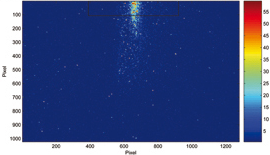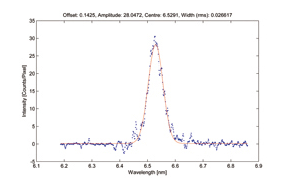Plot and numbers: the FLASH wavelength spectrum at 6.5 nm. Number of bunches: 2, aperture: 3 mm, wavelength: 6.523 nm, and bandwidth: 0.0266 nm (rms)

After a successful upgrade, the FLASH facility at DESY achieved a world premiere by generating flashes of laser light at the minuscule wavelength of 6.5 nanometres (nm), thereby breaking the world record of 13.5 nm it established one year ago. The facility now provides even better research opportunities for the second measuring period, which will begin in mid November.
In a maintenance shutdown that lasted several months, the linear accelerator of the 260-metre-long FLASH facility had been extended by 12 metres by installing a sixth superconducting module. As a result, the electrons could be accelerated for the first time to one gigaelectronvolt, the design energy planned for FLASH. This also created the necessary prerequisite for the generation of laser radiation with a wavelength of 6.5 nanometres.
"That we were able to reach the planned electron energy and wavelength so fast impressively confirms DESY's worldwide leading role in the construction and operation of X-ray free-electron lasers," said Professor Jochen R. Schneider, DESY Research Director. "At the same time, the research that can be carried out at these new facilities - which essentially amounts to 'filming molecules at work' - receives further impetus. This is of special significance now that the construction of the European XFEL facility in the metropolitan area of Hamburg is about to begin."

The FLASH facility of the DESY research centre started user operation in August 2005. Until 2009, it will be the world's only free-electron laser to deliver fast pulsed, powerful and ultra-short flashes in the soft X-ray range for research. Applications for the first measuring period, which ended in March 2007, already exceeded the amount of available beam time. In the end, it had to be shared among 16 projects, which were carried out at FLASH by 200 scientists from 60 institutes in 11 countries. Their research in various areas of physics, chemistry, or molecular biology already resulted in more than 35 published scientific articles. For the second FLASH measuring period, which will begin in mid-November and last 13 months, the international expert committee selected a total of 32 projects. Research subjects range from studies of transient plasma states to the imaging of single nanoparticles - from rare gas clusters to pico plankton - or studies of the electron dynamics of technically relevant materials in the femtosecond range.
(From: DESY Press Release Oct. 14, 2007)
| Further Links |





